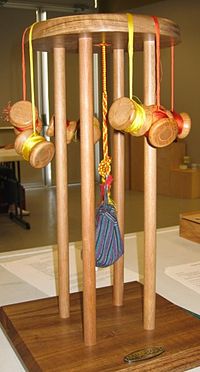- Marudai
-
A marudai (丸台 marudai) is a frame used for making kumihimo, a type of Japanese braid. The Japanese style marudai is 16" (40cm) high and is usually used while kneeling or when placed on a table. The Western style 26" marudai allows the braider to sit in a chair to braid. They are most commonly made out of wood, although sometimes plastic is the chosen material. Unlike kumihimo disks, marudais have no indication of where the thread should be placed; it is done freehand. To create the tension required for the rope to form, tama are rolled on the strands of threads, and a bag of counterweights are place at the base knot of these threads, where the rope begins. The tama are wooden bobbins that are often filled with lead or other heavy metals.
- Kagami[clarification needed]
- Kongō Gumi - a class of patterns for round cord all involving eight threads folded in half for a total of sixteen strands. In clockwise order, each bobbins is moved to the opposite side. When different combinations of thread color are used, many interesting patterns emerge, including diagonal stripes, diamonds on a background, triangles resembling hearts, and tiny six-petalled flowers. Kongō Gumi is named for the venerable Kongō Gumi company of Japan.
- Kumihimo or kumi himo - Japanese for "gathered threads".
- Obi - the broad cloth sash used in traditional dress.
- Obijime - the cord used to bind the obi secure.
- Omori[clarification needed]
- Takadai - a rectangular or square frame for kumihimo.
- Tama - little spools. The thread is kept from unwinding by passing the thread under itself, forming a loop around the tama. True silk is a hollow fiber with a rough surface that resists slipping past the loop unless gently pulled. For synthetic fibers, a flexible plastic "clamshell" bobbin may be preferable.
Books
- Creative Kumihimo, Jacqui Carey
- Beginner's Guide to Braiding, the Craft of Kumihimo, Jacqui Carey (Search Press)
Categories:- Japanese art stubs
- Braids
Wikimedia Foundation. 2010.



